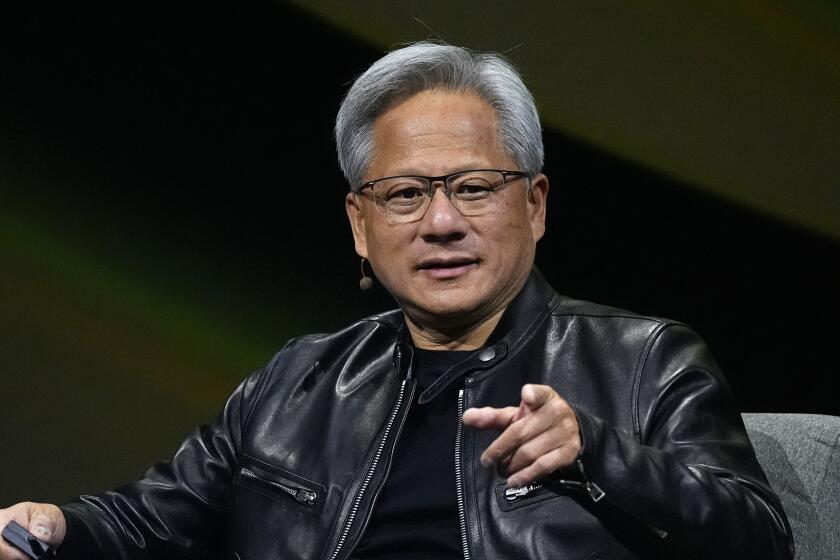Leaning on green to bolster revenue
Francisco Pinedo started making furniture as a teenager in the 1970s to make a little green.
He succeeded far beyond his expectations: By 2002 his Cisco Bros. Corp. furniture company was making $18 million a year in sales and he was celebrated as a local success story. But sales have slid since then as far-less expensive furniture made in China has made major inroads.
So to hold on to his business and hopefully keep it in Los Angeles, Pinedo took a new tack. He went green.
In 2005 Cisco Bros. began producing a line of furniture that used only reclaimed or sustainable woods, organic textiles and natural padding materials. Even the detergent used to wash the fabrics is environmentally friendly.
He’s not alone in looking to the environment to help out his business. Several local manufacturers have done the same as they searched for a way to stay in business -- and stay local -- in an increasingly competitive global market. The vast increase in attention to global warming and other environmental issues has given them a strong boost, especially in a region where it’s hip to be green.
“I was always close to the environment,” said Pinedo, 45, who grew up in a Mexican village so remote that there was no electricity. “It was out of a conviction that I wanted to do this. And then I realized it was also a great niche.”
It certainly helps companies get noticed.
“The environment is in the news every day,” said Frederic Scheer, chief executive of Cereplast Inc., a Hawthorne business that makes plastic resin from agricultural products instead of the usual fossil fuels.
“We are less than a drop in the bucket compared to companies like DuPont. But whenever something happens like Al Gore winning the Nobel Prize, it disturbs them and helps us. And that’s happening more and more,” Scheer said.
Some of these companies report that in just the last six months, they’ve seen consumer interest in their goods jump.
“The green people were always going to buy our products,” said Steve Carwile, chief executive of Vivetique Sleep Systems in Arcadia, which makes mattresses, comforters and other bedding products from natural materials. “But now we are getting to the people on the edge.”
Carwile, like Pinedo, first used conventional resources and techniques. His father began the mattress business in 1976 in their home’s garage in Temple City, using petroleum-based foam. But industry veterans hired as the business expanded taught them how to make the cotton-filled mattresses that were popular in the pre-foam era.
Slowly, the nonfoam products were introduced into the product line, and by the time Steve and his brother assumed ownership of the company in 1998, the majority of their mattresses were made of natural materials.
Since then they’ve gone all green. And although the price of Vivetique’s queen mattresses start at $1,200 and top out at $10,000 -- putting them solidly in the premium price range -- the business is steadily growing.
“The mattress industry is down across the nation because of the lapse in the housing market and the economy being a bit iffy,” Carwile said. “But we keep growing about 20% a year.”
In 2006, the company, which has 33 employees, had sales of about $4 million.
Scheer was green from the beginning. He founded Cereplast in 2001 and brought on board a group of scientists who developed a process that used starches made from corn, wheat, potatoes and other agricultural products to produce plastic resin. Normally, the resin is made from fossil fuels and is cheaper to produce.
But the surge in oil prices gave Cereplast a break.
“We were lucky,” Scheer said.
Suddenly, the company’s process made economic as well as environmental sense for some products. Its 2007 sales are expected to hit $1.5 million, more than double what it did in 2006.
Among Cereplast’s biggest customers are companies such as Solo Cup, which uses the all-natural resin in making disposable plates, cups and cutlery.
The company also has developed a hybrid resin that is only about 50% from natural sources. It can be used to make sturdier and longer-lasting products such as cellphone cases or even automobile parts.
“An automobile is not something that is going to be driven into a compost heap when it is finished, anyway,” Scheer said.
Cereplast plans to start building a second plant next year that will be outside California but still in the U.S. (Scheer declined to name the state.)
The company is only a tiny entity in the plastic world.
“We make about 45 million pounds of our resin product a year,” he said. “That’s compared to 250 billion pounds total made in the U.S., and worldwide, a trillion.
“But there are companies calling on us because they are trying to bring their image around to green.”
Scott Brown’s Anaheim company, Southern California BioFuel Inc., makes biodiesel fuel that can run in any vehicle equipped for diesel.
His source material is leftover oil from fast-food chains and other restaurants that he filters and refines.
Last year he produced a million gallons; this year it will be more than 3 million.
“I can’t keep it in stock,” said Brown, who sells about half the production to distributors and the other half to consumers who come to the pump at his plant. His fuel price is competitive with the typical cost of diesel in Southern California.
For some of these businesses, it’s a race against time. They must survive until environmentalism is a big enough draw to fuel growth. And there is always the chance they could be pushed aside by larger companies getting into the green game, even if located an ocean away.
One thing the local companies have going for them is that they’re local.
“People are becoming more aware that if they buy a green product, the benefits of that to the environment is diminished if it was made thousands and thousands of miles away,” said Carolyn Allen, publisher of the online trade journal California Green Solutions. “Then the air is polluted by the transportation of it.”
Still, Pinedo is in a particularly precarious position. A sofa that costs him $1,000 to make in L.A. could be produced in China for only about $250, he said, mostly because of labor costs.
“There is no way you can compete with that,” he said. His wholesale business fell off as much as 50% from its peak years.
“If I had moved the business overseas right then, we would be a much bigger company today,” he said.
The transition to green production was made on several levels. He switched to sustainable woods and natural fabrics for all his products.
Some pieces were made with only environmentally friendly materials, and Cisco Bros. customers were told that any item could be made all green on order.
But the majority of upholstered goods were still made with some man-made products. At the 80,000-square-foot factory in South Los Angeles, workers making cushions with undyed, natural wool were only a few feet way from those using foam.
Pinedo also moved into retail. He opened two stores -- one in Los Angeles on La Brea Avenue near other furniture and design shops and the other in Pasadena.
This was done in part to push his all-green products, which now make up about 30% of Cisco Bros. stores’ sales.
“A year ago, people probably didn’t know green furniture existed,” he said. “Six months ago, it was still rare to get an order. Then people started to come into the stores very curious. Some of them come with the determination to buy these items.”
Of course, there was a cost to opening the stores. And revenue, although not in free fall, is soft. Pinedo predicts that sales this year will be about $15 million, with about 15% of that attributable to all-green products. The current workforce is at 160, down from a high of 220.
“I just don’t see how this can’t work,” Pinedo said. “We are making a well-designed product that is good for people. And we are letting people know we exist, selling our products directly.”
--
More to Read
Inside the business of entertainment
The Wide Shot brings you news, analysis and insights on everything from streaming wars to production — and what it all means for the future.
You may occasionally receive promotional content from the Los Angeles Times.










